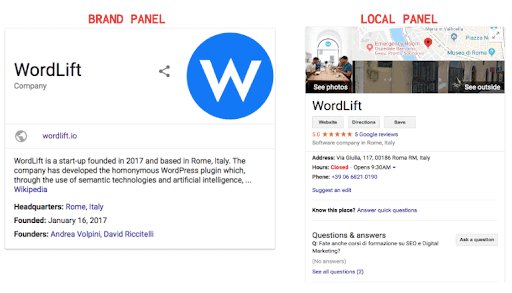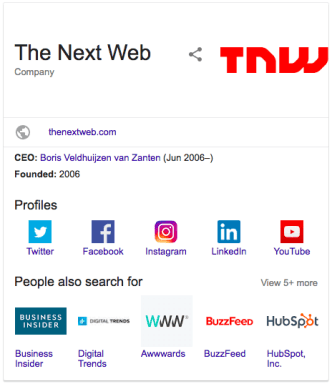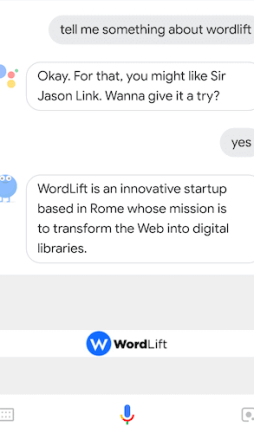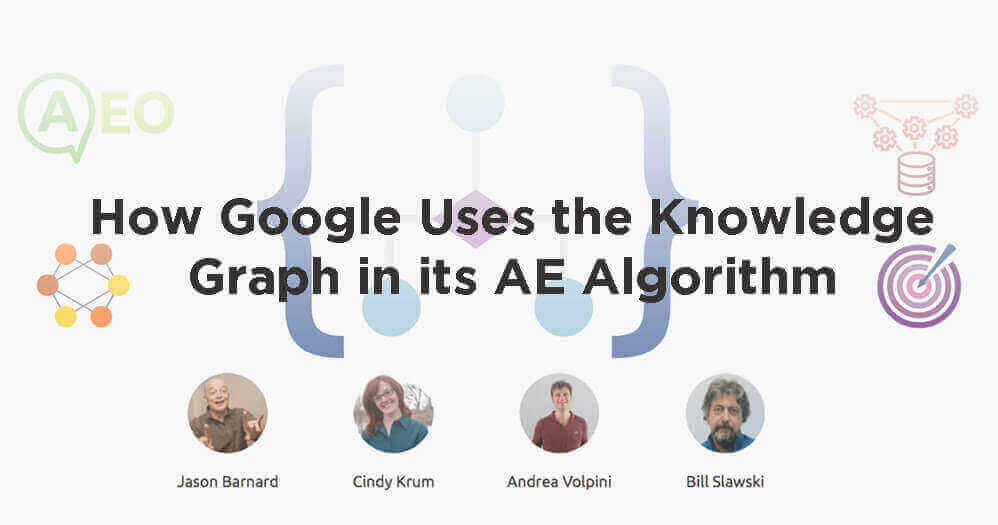In this article, we analyze how we can optimize the content on our website to gain premium real estate in Google SERP, by providing hyper-relevant information for the Google Knowledge Graph.
What is Google Knowledge Graph?
The Knowledge Graph is a vast database launched by Google on May 16, 2012 designed to provide more useful and relevant results to searches using a semantic-search technique. Find out more about the Google Knowledge Graph.
Every day, here at WordLift, we spend a great amount of time talking with experts in the digital marketing world and experimenting new ways to stand out on Google and Bing by getting better at organizing knowledge.
To help websites improve their SEO our secret weapon is to create a knowledge graph that is openly accessible to crawlers and linked from the content of the website using structured data markup.
What is a Knowledge Graph?
A knowledge graph acquires and integrates information into an ontology and applies a reasoner to derive new knowledge.
(Lisa Ehrlinger and Wolfram Wöß – University of Linz in Austria)
The term knowledge graph has been frequently used in research and business, in close association with Semantic Web technologies, linked data, web-scale data analytics, and cloud computing. At SEMANTiCS, a few years ago, a research paper titled “Towards a Definition of Knowledge Graphs” by the Institute for Application Oriented Knowledge Processing of the University of Linz was presented to propose a definition of the knowledge graph that focuses on data modeling and reasoning.
Read more about Knowledge Graph definition.
What is a Knowledge Panel?
A knowledge panel is information about a business, a person or a topic in a box that appears to the right of Google search results. The information in the box is powered by Google Knowledge Graph and provides all sort of relevant facts about an entity.
Knowledge panels are a great way to gain visibility in Google search results and an entry point also for voice search in most cases. There are mainly two types of panels:
- Local Panels that display information about a business that has an open Google My Business account
- Brand (or personal) Panels that display information about an organization with a certain degree of authority. In our case having an article in Wikipedia was helpful to gain this panel.
While it is much harder to influence Google in creating a branded or personal knowledge panel we have succeeded in several cases with both organizations and persons that did not have a presence in Wikipedia.
Have a look below at the knowledge graph panel of TheNextWeb and all the information that it provides to online users.
Why creating your own Knowledge Graph improves SEO?
Imagine the knowledge graph behind your website as the scaffolding that lets crawlers and bots access to your content in a smarter and more efficient way. Much like Google uses the graph, as the engine to power up its search results, a graph that describes the content of a website helps machine understands what this content is really about.
Whether is a featured snippet showing on the SERP of Google or an app providing an answer using the voice like Cortana, Alexa or the Google Assistant, in the back, everything depends on the data that connects articles and facts in a machine-friendly form.
This is why having your own knowledge graph helps you make your content easier to be found and more accessible. Let’s dive into the practice and let’s try to ask the Google Assistant something like “what is Semantic SEO“. You will get as answer a snippet of content taken from this same blog.
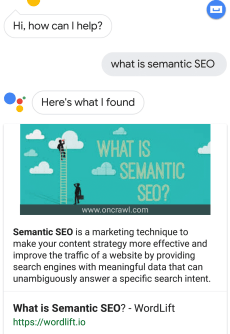
What is Semantic SEO on the Google Assistant
The more metadata we make available to semantic search engines like the one used by Google Assistant and the easier it gets for these machines to understand the relevancy of our content in relation to a specific intent. Let me give you another example of content findability in the new world of personal assistant search optimization where a knowledge graph comes into play.
Here below the query to trigger is “tell me something about WordLift“. In this specific example, the Google Assistant proposes to the user the invocation of a Google Action called Sir Jason Link that can match this request.
The Google Action – Sir Jason Link – has been created using the graph data behind this website much like in the previous example.
The Google Assistant has analyzed the content of the Google Action (imagine a Google Action much like an app for the Google Assistant or the equivalent of a skill for Amazon Alexa) and probably has seen that the content matches the content on this website. The assistant is, therefore, suggesting to users, that might not know Sir Jason Link, to invoke it when asking for our product.
You can find out more on how to optimise your content for Google Actions on WooRank’s blog.
There is more SEO value than featured snippets, voice search and personal assistant search optimization in creating a linked graph with the metadata of a website.
In today’s digital world, publisher and readers are overwhelmed with information and it gets increasingly complicated to discover the content we really want. Semantic Technologies, like WordLift, do the magic and help publishers create better content while guiding readers in finding the content they want.
In SEO terms, articles enriched with semantic information, improve their findability by making information extraction more efficient. Concepts mentioned in an article are annotated and linked with extensive knowledge bases (such as DBpedia, Wikidata, Geonames and the Google Knowledge Graph) to provide search engines with key indications on why a specific piece of content can be relevant for a given search intent.
More importantly – all the information is structured in a graph – this means that a search engine can process, all it has to know about an article, much like we do when looking at the nutrition facts label on a pack of spaghetti. All the relevant information is condensed in a label that is easy to read and organized in a standard way.
How Google uses the Knowledge Graph to answer your questions?
In this webinar organized by Jason Barnard, I had the opportunity to discuss with Bill Slawski and Cindy Krum how Google is using the Knowledge Graph in its AE algorithm and how things really work. If you want to dig into the topic of Knowledge Graph and SEO watch it now!
Our main goal with WordLift was really to improve the linked data graph in order to:
- Be able to compute and analyze the relationship between entities and articles being annotated. Here, as a side effect, we will have a lot more links from the graph to the articles and this will facilitate the indexation of articles,
- Improve how smart agents (or crawlers) access information about entities using the semantic technology language of RDF and SPARQL this basically means, for instance, that we can handle queries to event-related questions like:
- What are the next events in Paolo Alto?
- What are the upcoming talks with Gennaro Cuofano?
- How much does it cost to attend the Meetup on AI & ML for WordPress?
Check out below a sample dialogue that Sir Jason Link (WordLift’s powered Google Action) can support thanks to this new update.
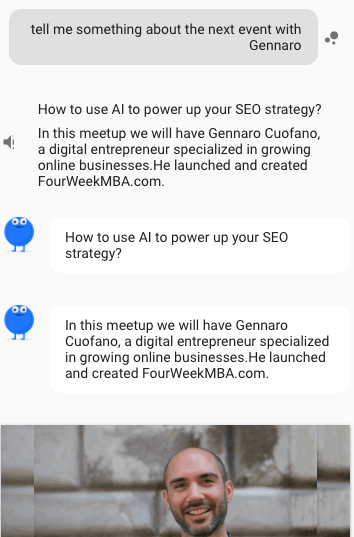
Asking Sir Jason Link about Gennaro’s upcoming event.
Want to learn more about how WordLift works? ? BOOK A DEMO
As we have seen with a smarter knowledge graph publishers can create SEO-friendly content and open up their website to new and engaging ways to connect with their audiences and grow their traffic.
Find below one more example of a query that users can trigger using the query language SPARQL to find out events happening in a specific location.
Ready to build your own graph? ? START A TRIAL
Must Read Content
The Power of Product Knowledge Graph for E-commerce
Dive deep into the power of data for e-commerce
Why Do We Need Knowledge Graphs?
Learn what a knowledge graph brings to SEO with Teodora Petkova
Generative AI for SEO: An Overview
Use videos to increase traffic to your websites
SEO Automation in 2024
Improve the SEO of your website through Artificial Intelligence
Touch your SEO: Introducing Physical SEO
Connect a physical product to the ecosystem of data on the web

